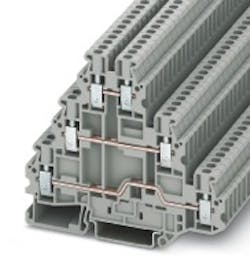Triple-level Screw-clamp Terminal Blocks Conserve DIN Rail Space
The UT 2.5-3L accepts solid, stranded or ferruled wires with 26-12 AWG.
Push-in bridging on each level saves space while distributing power. Vertical bridges electrically connect all three levels to one another. Each terminal point has a large labeling space for easy identification.The UT 2.5-3L series features Phoenix Contact's Reakdyne screw-clamp design to prevent screws from backing out. Components are manufactured from corrosion-resistant copper alloy. This robust design makes the terminal blocks ideal for mission-critical applications. The UT line of terminal blocks is widely found in energy, oil and gas, water treatment, machine building and other industrial automation systems.
UT 2.5-3L terminals have current ratings of 300 V at 20 A or 600 V at 5 A* under UL file # E60425. *These limited ratings are applicable for use in or with industrial control equipment where the load on any single circuit does not exceed 15 A at 51-150V; 10 A at 151-300V; or 5 A at 301-600 V, or the maximum ampere rating, whichever is less.
The series is part of Phoenix Contact's CLIPLINE Complete system, which features standardized push-in bridging, marking and testing accessories for all connection technologies.
Phoenix Contact - www.phoenixcontact.com

